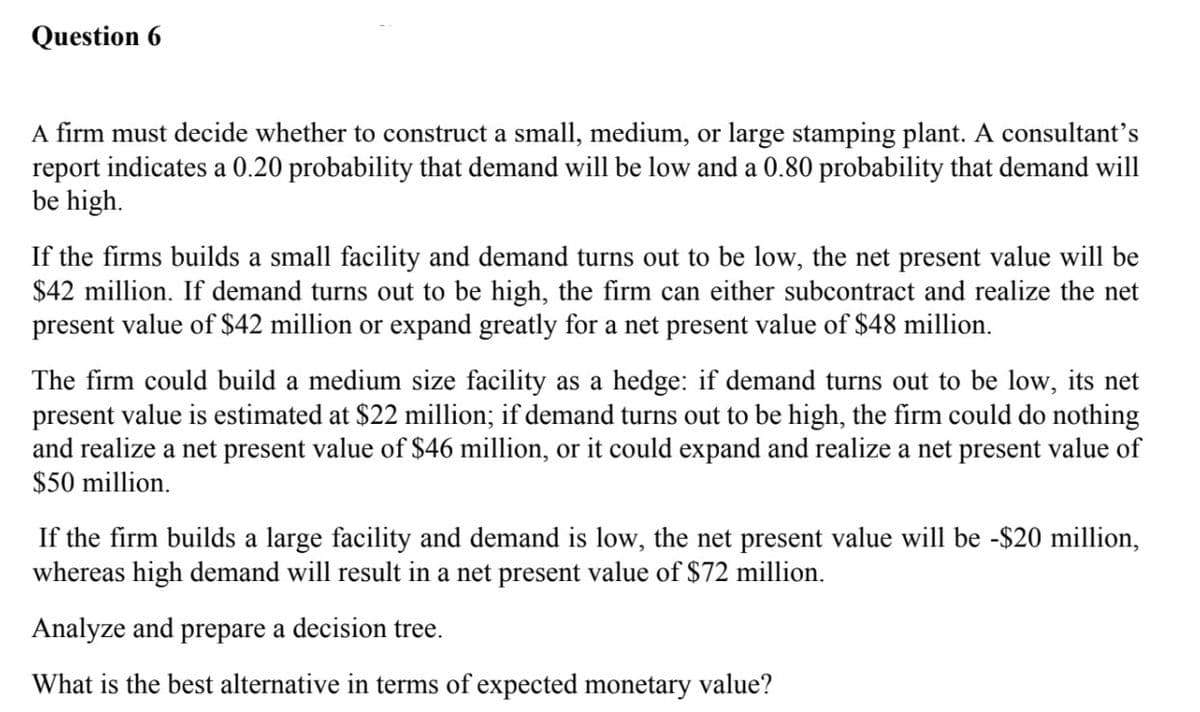A firm must decide whether to construct a small, medium, or large stamping plant. A consultant's report indicates a 0.20 probability that demand will be low and a 0.80 probability that demand will be high. If the firms builds a small facility and demand turns out to be low, the net present value will be $42 million. If demand turns out to be high, the firm can either subcontract and realize the net present value of $42 million or expand greatly for a net present value of $48 million. The firm could build a medium size facility as a hedge: if demand turns out to be low, its net present value is estimated at $22 million; if demand turns out to be high, the firm could do nothing and realize a net present value of $46 million, or it could expand and realize a net present value of $50 million. If the firm builds a large facility and demand is low, the net present value will be -$20 million, whereas high demand will result in a net present value of $72 million. Analyze and prepare a decision tree.
A firm must decide whether to construct a small, medium, or large stamping plant. A consultant's report indicates a 0.20 probability that demand will be low and a 0.80 probability that demand will be high. If the firms builds a small facility and demand turns out to be low, the net present value will be $42 million. If demand turns out to be high, the firm can either subcontract and realize the net present value of $42 million or expand greatly for a net present value of $48 million. The firm could build a medium size facility as a hedge: if demand turns out to be low, its net present value is estimated at $22 million; if demand turns out to be high, the firm could do nothing and realize a net present value of $46 million, or it could expand and realize a net present value of $50 million. If the firm builds a large facility and demand is low, the net present value will be -$20 million, whereas high demand will result in a net present value of $72 million. Analyze and prepare a decision tree.
Managerial Economics: A Problem Solving Approach
5th Edition
ISBN:9781337106665
Author:Luke M. Froeb, Brian T. McCann, Michael R. Ward, Mike Shor
Publisher:Luke M. Froeb, Brian T. McCann, Michael R. Ward, Mike Shor
Chapter17: Making Decisions With Uncertainty
Section: Chapter Questions
Problem 2MC
Related questions
Question
SUBJECT:
Number 6

Transcribed Image Text:Question 6
A firm must decide whether to construct a small, medium, or large stamping plant. A consultant's
report indicates a 0.20 probability that demand will be low and a 0.80 probability that demand will
be high.
If the firms builds a small facility and demand turns out to be low, the net present value will be
$42 million. If demand turns out to be high, the firm can either subcontract and realize the net
present value of $42 million or expand greatly for a net present value of $48 million.
The firm could build a medium size facility as a hedge: if demand turns out to be low, its net
present value is estimated at $22 million; if demand turns out to be high, the firm could do nothing
and realize a net present value of $46 million, or it could expand and realize a net present value of
$50 million.
If the firm builds a large facility and demand is low, the net present value will be -$20 million,
whereas high demand will result in a net present value of $72 million.
Analyze and prepare a decision tree.
What is the best alternative in terms of expected monetary value?
Expert Solution
This question has been solved!
Explore an expertly crafted, step-by-step solution for a thorough understanding of key concepts.
Step by step
Solved in 2 steps with 1 images

Knowledge Booster
Learn more about
Need a deep-dive on the concept behind this application? Look no further. Learn more about this topic, economics and related others by exploring similar questions and additional content below.Recommended textbooks for you

Managerial Economics: A Problem Solving Approach
Economics
ISBN:
9781337106665
Author:
Luke M. Froeb, Brian T. McCann, Michael R. Ward, Mike Shor
Publisher:
Cengage Learning


Managerial Economics: A Problem Solving Approach
Economics
ISBN:
9781337106665
Author:
Luke M. Froeb, Brian T. McCann, Michael R. Ward, Mike Shor
Publisher:
Cengage Learning
